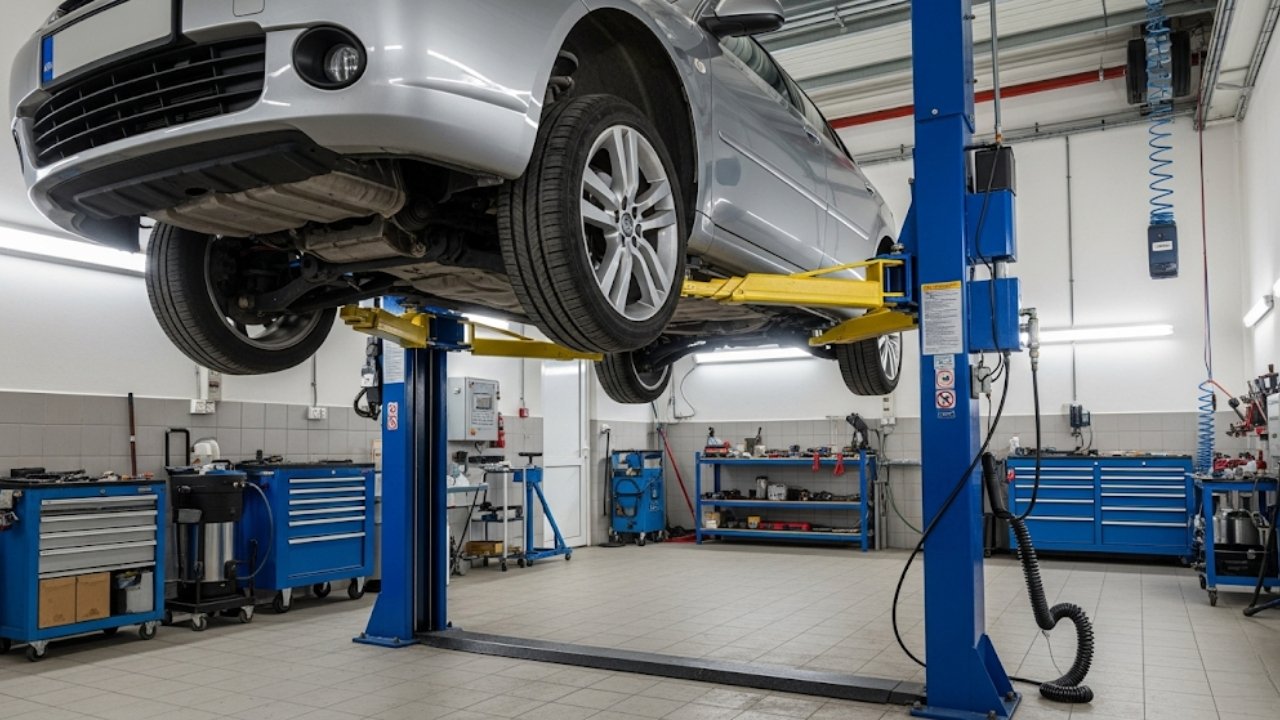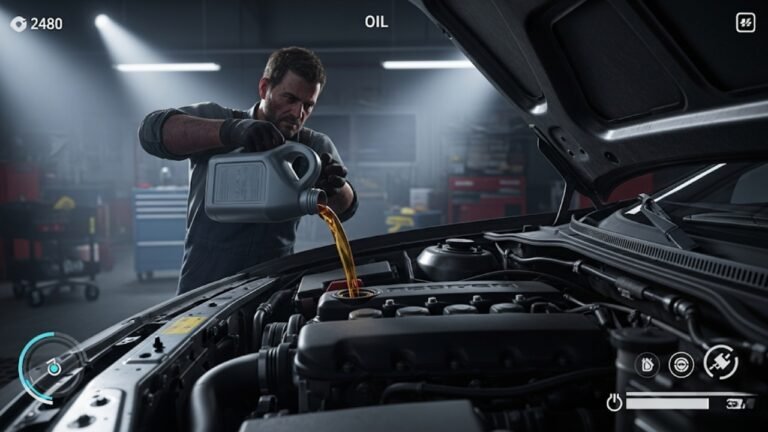How a 12,000-N Car is Raised Using a Hydraulic Lift

Imagine you’re at an auto repair shop. The mechanic pushes a lever gently, and a car weighing as much as a small elephant starts to rise smoothly. No loud motors. No sweat. It almost feels magical.
But this isn’t magic. It’s pure physics—hydraulics to be exact. One of the most fascinating examples is when a 12,000-N car is raised using a hydraulic lift, which consists of a U-tube with arms of unequal areas filled with oil. The car rests on a larger piston, and a smaller piston is pushed to lift it.
This article will walk you through how that’s even possible, the physics principles involved, and how much force you’d need to apply to the smaller piston to lift the car. Whether you’re a curious student, a car enthusiast, or just someone who loves breaking down big ideas into small ones—you’re in for a treat.
Understanding the Setup: What Are We Working With?

Here’s what we know:
A 12,000-N car is resting on the larger piston of a U-shaped hydraulic lift.
The system uses incompressible oil and tight-fitting pistons.
The wider arm (where the car sits) has a radius of 18.0 cm.
The narrower arm (where you apply force) has a radius of 5.00 cm.
The pistons are initially level, and we neglect the weight of pistons for simplicity.
Hydraulic systems are based on Pascal’s Principle, which states that pressure applied to a confined fluid is transmitted undiminished in all directions. That’s the golden key.
Breaking It Down: The Hydraulic Principle at Work
Hydraulics isn’t just about oil and tubes. It’s about transmitting force through a fluid.
In simple terms:
Force = Pressure × Area
According to Pascal’s Principle:
Pressure on both sides must be equal when the system is in balance.
So when we push the smaller piston, it creates pressure in the oil. That pressure then travels through the fluid and pushes up on the larger piston holding the car.
Let’s create a simple analogy here:
Think of a teeter-totter (seesaw). If one side is longer, you need less weight to lift a heavier object on the other side. In hydraulics, area replaces length, and pressure equalizes the force.
Calculate the Piston Areas
We’ll first need to find the area of each piston using the formula for the area of a circle:
A = πr²
Wider Arm (Car Side)
Radius = 18.0 cm = 0.18 m
A₁ = π × (0.18)² ≈ 0.1018 m²
Narrower Arm (Force Applied Side)
Radius = 5.00 cm = 0.05 m
A₂ = π × (0.05)² ≈ 0.00785 m²
Here’s a quick summary:
| Component | Radius (m) | Area (m²) |
|---|---|---|
| Larger Piston | 0.18 | 0.1018 |
| Smaller Piston | 0.05 | 0.00785 |
This table helps you clearly see the area difference, which is crucial to understanding why small input can lead to large output.
Find the Pressure Needed to Lift the Car
Now let’s figure out the pressure needed to lift the car.
We know:
Force = 12,000 N
Area = 0.1018 m²
Using the pressure formula:
P = F / A
P = 12,000 N / 0.1018 m² ≈ 117,852 Pascals (Pa)
So, we need about 117,852 Pa of pressure in the fluid to lift the car.
Now let’s find out what force you need to apply on the smaller piston to create this pressure.
Apply Pressure to the Smaller Piston
If pressure must be the same, we use:
F = P × A
Here:
P = 117,852 Pa
A = 0.00785 m² (smaller piston)
Then:
F = 117,852 × 0.00785 ≈ 925 N
So, the initial force required to lift the car is approximately 925 Newtons.
Let that sink in for a second.
You’re lifting a 12,000 N car—roughly the weight of a fully loaded minivan—with a push of just 925 N, thanks to hydraulic advantage.
Putting It All Together: From Numbers to Reality
To recap:
You’re using a hydraulic lift with unequal piston sizes.
The car side piston has a radius of 18.0 cm.
The smaller piston, where you apply force, has a radius of 5.00 cm.
Applying just 925 N of force to the smaller piston creates enough pressure to lift the 12,000 N car.
This shows how hydraulics helps you do big things with small effort. It’s the same principle behind brake systems, excavators, and airplane landing gear.
Why This Matters: Real-Life Relevance
So, why should you care? This isn’t just for physicists or mechanics.
Understanding how a 12,000-N car is raised using a hydraulic lift gives you a real-world appreciation of how simple laws of physics power our most advanced machines.
Whether you’re:
Changing a tire,
Observing how brakes work, or
Using a jack to raise a car in your garage,
You’re interacting with hydraulic power every day—often without even knowing it.
This topic isn’t just theory. It’s the foundation of tools that keep us moving, safe, and efficient.
Bullet Recap: Quick Key Takeaways
Main keyword: a 12,000-N car is raised using a hydraulic lift
Hydraulic systems work on Pascal’s Principle.
Pressure is transmitted equally through incompressible fluids.
Larger piston (car side) has greater area.
Smaller piston requires only 925 N of force to lift the car.
This is how small inputs can create massive outputs.
The Metaphor of a Bicycle Pump: Why Force Multiplies
Let’s simplify this even further.
Imagine using a bicycle pump. You push the handle down. Air moves and fills the tire. Now imagine if that air were oil and instead of inflating a tire, you were lifting a car.
This is the beauty of hydraulics. Just like a pump magnifies the effect of your hand movement, a hydraulic system multiplies your force using fluid pressure and surface area.
What’s amazing is that your 925 N push on the smaller piston doesn’t lift just the edge of the car—it raises the entire 12,000 N weight. That’s a ratio of over 13:1 in force multiplication. You’re getting more than 13 times your input back in output, all thanks to physics.
Hydraulics in Everyday Life: Hidden Power at Work
Hydraulics are not just in car lifts. They’re everywhere.
Elevators use hydraulic rams to smoothly raise and lower platforms.
Backhoes and cranes rely on hydraulic arms to move tons of dirt or steel.
Even car brakes use hydraulics to stop a speeding vehicle with just a light tap.
Think about that for a second. You’re cruising at 90 km/h, and a gentle press on the brake pedal translates through fluid to stop over a ton of metal in seconds. That’s not just technology—it’s trust in fluid mechanics.
When you understand how a 12,000-N car is raised using a hydraulic lift, you start seeing how nature and design work together. It’s not brute strength—it’s smart application.
Cultural Insights: A Garage in Bangladesh or Brooklyn
Whether you’re in a rural village in Bangladesh or a busy shop in Brooklyn, mechanics rely on the same principle.
In a Dhaka roadside garage, a mechanic might use a manual hydraulic jack to raise a microbus. He’s not doing it with muscle, but with knowledge. One downward stroke at a time, he pushes oil through a narrow tube into a larger cylinder, lifting the car safely.
In the U.S., a technician may use a powered hydraulic lift, but the math—and the magic—is the same.
It’s beautiful how this one law—Pascal’s Principle—crosses borders, tools, and industries. It’s universal.
The Trade-Off: Distance vs. Force
Here’s something to think about.
Yes, you only need 925 N to lift the car. But—there’s a catch.
The smaller piston has to move a much longer distance than the car rises. Why? Because energy must be conserved.
Work = Force × Distance
So, if you apply a small force, you must do it over a longer distance. That’s the trade-off. It’s like gears on a bicycle: low gear is easier to pedal but you travel slower.
Hydraulic systems behave the same way. The smaller piston travels further so the bigger one can rise gently but powerfully.
Why the Fluid Matters: Oil is King
You might wonder—why oil?
Oil is nearly incompressible, which means it doesn’t shrink or expand when pressure is applied. That makes it perfect for transmitting pressure evenly through the system.
Also, oil provides:
Lubrication for moving parts
Corrosion protection
Temperature stability
If you used water or air, it wouldn’t work as reliably. Air compresses. Water can rust metal. Hydraulic oil is specially designed for this kind of job.
Real-World Analogy: Lifting a Car with Your Pinky
Let’s turn this into a relatable experience.
Imagine you’re trying to lift a car with your pinky finger. Impossible, right?
But what if your pinky could push a small piston, and that piston could create enough pressure in oil to lift the car?
That’s exactly what’s happening here.
By manipulating surface area differences, you’ve essentially created a mechanical superpower.
This isn’t fiction. It’s physics. And it’s happening in every mechanic’s shop every single day.
FAQs
Q1: What is Pascal’s Principle?
Pascal’s Principle states that any change in pressure applied to an enclosed fluid is transmitted undiminished to every part of the fluid and the walls of its container. It’s what makes hydraulic lifts and braking systems work so efficiently.
Q2: Why are the piston sizes different in a hydraulic lift?
The difference in sizes provides a mechanical advantage. The smaller piston requires less force, but must move a greater distance, while the larger piston lifts heavier loads with that pressure.
Q3: Can I lift any car with a hydraulic lift like this?
Theoretically, yes—if the lift is built for the car’s weight. But in practice, each lift has a weight rating. Never exceed it, or you risk failure and injury.
Q4: How do mechanics maintain hydraulic lifts?
They regularly check for oil leaks, replace seals, and bleed the system to remove trapped air. Maintenance ensures the system remains safe and reliable.
Q5: Can hydraulic lifts fail?
Yes—usually due to seal leaks, air in the system, or oil contamination. But with good design and regular maintenance, failure is rare.
Q6: What happens if air gets into the hydraulic fluid?
Air is compressible. If it enters the system, it causes spongy movement or loss of power. That’s why systems are bled (like brakes) to keep them efficient.
Q7: Is the 925 N force the same every time?
Only if the system remains the same. If fluid level, temperature, or piston size changes, the required force will change too.
Q8: Why not make the smaller piston even smaller to use less force?
Good question! If the smaller piston is too small, you’d need to move it a very long distance, making the process slow and impractical. It’s all about balancing force and distance.
Conclusion: Simple Physics, Big Impact
In the world of machines and mechanics, the concept that a 12,000-N car is raised using a hydraulic lift may seem like a technical marvel—but it’s actually a simple truth.
With a push of 925 N on a smaller piston, pressure spreads through a tube filled with oil, and that force gets multiplied to lift a car.
We don’t often think about the laws of nature in our daily life, but they’re behind the cars we drive, the planes we fly, and the machines that build our cities.
Next time you see a car rising slowly in a repair shop, take a moment to appreciate the quiet, invisible strength underneath it. It’s not just metal and oil—it’s the power of applied knowledge.
So whether you’re a student, a mechanic, or a curious mind—remember, understanding small things leads to big breakthroughs.






